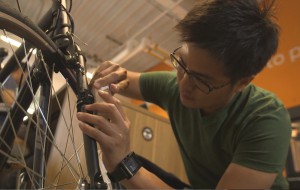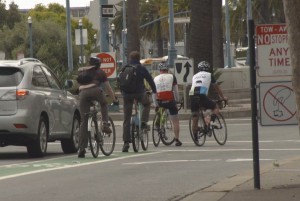
Ford hopes to help ease congestion in large cities by helping drivers find parking spots more quickly, including using sensors on bikes to provide information.
Ford Motor hopes to use technology spawned in Silicon Valley to help meet one of the biggest challenges facing motorists today – finding a parking space.
Michael Tinskey, Ford global director of electrification and infrastructure, told the annual “Further With Ford” conference, which was held in the automaker’s new research and development center in Palo Alto, California, just outside San Francisco that finding a parking space is becoming more and more of challenge.
Thus, Ford is looking at the utility of a system that can help drivers hunt for a parking space in heavily congested cities, such as Los Angeles and San Francisco. By one estimate roughly 30% of air pollution around Los Angeles might be caused by drivers hunting for parking spaces.
Finding parking is one element of Ford’s ongoing efforts to improve the mobility of its customers, Tinskey said.
(To see more about Ford moving its Smart Mobility program to the pilot stage, Click Here.)
Only about 12% of the drivers actually find a space within five minutes, while at the other end of the spectrum a significant percentage of drivers spend more than 25 minutes looking for a parking space. “How do we identify open parking space?” he said.
One solution could be to use the same sensors that feed traffic information to services, such as Inrix, which tracks traffic conditions in real time to also provide information about open parking spots or parking lots with free spaces. One of the immediate benefits would be a reduction in congestion, said Tinskey, who added the software solution linking the parking search to the navigation function is relatively inexpensive.
(Click Here for details about Ford’s introduction of its Smart Mobility plan.)
Ford is also considering using bicyclists to help search for empty parking spots as part of a project how bicycles can be best used in urban environments. Both consumers and municipalities can use data from bike sensors, Ford officials said.
Sensors on bicycle can provide information about traffic patterns, pedestrians and road conditions that is difficult to obtain from vehicle sensors. Thus, in the future, this data may be combined with vehicle data to analyze road quality, characterize micro-climates, or identify traffic patterns throughout the day.
(Ford outlines plans for autonomous vehicles. For more, Click Here.)
For example, city planners could use this information to create bike lanes. Bike riders could get insights on best routes or real-time information on areas to avoid. Bikes also could provide up-to-date-information on local weather conditions in a small area, which could be critical to the operation of autonomous vehicles, according to Kenneth Washington, the head of Ford’s research effort in Silicon Valley.


Bikes are not the solution for most people. Good public transportation in dense population areas is useful.